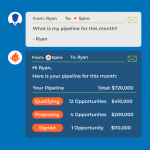AI And Marketing’s Holy Grail
by Mike Azzara, Op-Ed Contributor, November 10, 2016

Writing for AI Insider was an offer I could not resist. As a tech journalist, editor and publisher for some 34 years and six months now, and a sci-fi aficionado all my life, I like to think I understand better than most how technological advances really happen: through unique confluences of science, imagination, and serendipity.
From Jules Verne’s submarine and moon landing to Asimov’s three laws of robotics (first written into a 1942 short story, their potential importance to modern AI is seriously discussed in this May 2016 MIT Technology Reviewarticle), science’s thinkers dream and its engineers and programmers strive to manifest those dreams. Serendipity governs who wins, who loses — and all the unintended consequences. How long before humanity comes down with the first man-made information virus, a la Neal Stephenson’s novel “Snow Crash”?
But I digress.
Artificial intelligence and its machine learning branch, in particular, are still rapidly ascending the steep slope of Gartner’s infamous Hype Cycle. You’ve all read the headlines: speech and image recognition, self-driving cars, Siri, Cortana, Alexa, Assistant, the chatbot fiasco, the privacy concerns, the ethics dilemmas. AI/ML promises to provide marketers with tools to meet potential buyers wherever they are hiding, deduce their intent, serve them content ideally suited to their momentary needs, incite their action and achieve desired business outcomes.
Meanwhile, today, here’s what AI/ML is actually doing for marketers: incrementally improving ROI in programmatic advertising, primarily because ML algorithms can make decent choices in real time when humans are too slow.
We will get there, however — and fast. One thing you learn studying new tech for 34.5 years is how to tell when a technology becomes inevitable. Another: the moments at which adoption accelerates. In this case, AI/ML’s growth will be explosive because smart-enough processors and cheap-enough storage already are on the scene, and the infrastructure those artificial brains require to do their voodoo already exists. By that I mean the digital networks enveloping us all, and getting more sensitive and more precise every week. Those networks generate amazing amounts of data and, like No. 5 in “Short Circuit,” AI/ML demands vast oceans of data.
(Data proliferation digression: In 2014, humanity created 1.7 megabytes of new information, every minute, for every person on earth, according to the International Data Corporation.. The company also says the cumulative total of the world’s digital data reached 4.4 zettabytes in 2013 — but by 2020 we’ll create 44 zettabytes of new data every year. (A zettabyte = 1 trillion gigabytes.)
So I figure writing this column regularly is my chance to chronicle the transition of AI/ML in advertising and marketing, from a little incremental ROI improvement to the massive upheaval of all the world’s economies as they transform from “make and sell” business models to “sense and respond” — and, ultimately, “predict and anticipate” models. Along the way, I’ll try to provide pragmatic information — AI/ML-based products and services available today and what your peers are actually accomplishing with them — interspersed with the visionaries’ dreams. Because you have to have both the imagination and the science — and you all add the serendipity.
Some of my initial thoughts about what we’ll cover:
New-age customer experiences. As my buddy Ted Kohnen, managing director of Stein IAS’ San Francisco office, recently told me, “We have the data, the technology and the content. So how can we use AI to create a breakthrough experience for a target? I mean a hyper-relevant, meaningful experience that leads you to take action?” Chatbots and first-person-view virtual reality are just two of the front-end tools in which AI will manifest to create breakthrough digital customer experiences.
The Holy Grail: What the customer will do next. Deducing momentary intent is one thing; Google does that pretty well already. Some AI/ML-based systems are learning to use contextual clues and behavioral cues to figure out where someone is in their own personal version of the postmodern, non-linear buyer’s journey and respond accordingly (sense and respond). Ted anticipates the coming of a “Minority Report”-like capability to foretell what customers will want next (predict and anticipate). All we’d need is a thorough understanding of the deep-rooted patterns governing human behavior (kind of like Hari Seldon’s science of psychohistory) combined with those aforementioned vast oceans of data and an AI brain on the order of Deep Thought (Douglas Adams’ Deep Thought, not IBM’s). This boy just wants to have fun illuminating what’s possible here.
The blurry line where big data analysis ends and AI begins. When you talk to marketers using AI, sometimes it sounds like fairly basic stuff. Can’t they figure that out by querying a big, smart database? Sometimes. But do you want to be sitting there writing SQL when a prospect bangs on your site to download a case study? Or do you want to know you’re the third vendor whose case study she just downloaded, her boss gave her until Friday to decide whose service to buy, and now’s the moment at which your appropriate response can seal the deal? Decide and act in real time, baby. You need an AI to do that for you, because you can’t code business logic for all the possible permutations.
Process … Approach … Business Behavior … Culture? Call it what you will, but in order to truly realize the value of AI/ML capabilities a whole lot of brand and agency marketing teams will have to stop doing the things that made them famous and start behaving in whole new ways. One example: if you want to use an AI to feed the perfect banner creative to any given individual at any moment in time, followed up with the perfect content asset, you need giant pools of creative and content executions. Robust, comprehensive, ready-to-go — at launch. This isn’t A/B testing. This is organizational change management. Success will require new kinds of collaboration among creative, content and media planning, and different deliverables.
You. In closing, I ask for your stories. To help marketers most requires that a journalist collect real-life experiences from people on the front lines. What’s your most advanced use of AI/ML? How’d it work out for you or your client? Both on- and (especially) off-the-record. Of course it’s better to point to a known source, but as a content marketer I’ve also learned about the value of privately sourced insights and readers’ increasing ability to identify honest, authentic content all on their own.
I’m looking forward to this journey.
MediaPost.com: Search Marketing Daily
(33)













